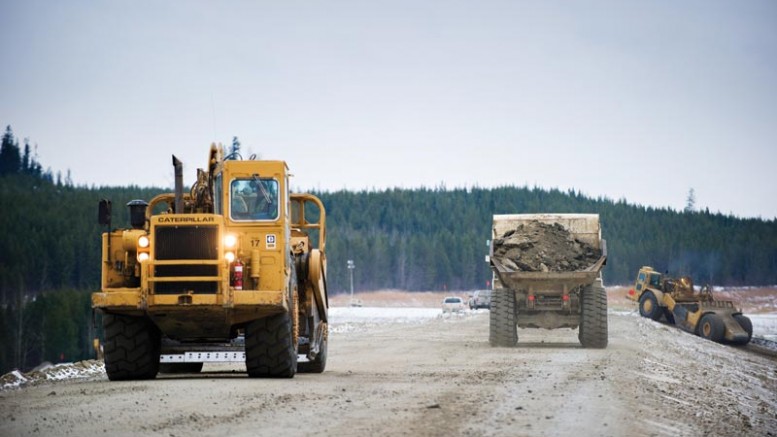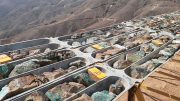While gold miners have been stealing the pandemic limelight as that precious metal’s price has soared, copper miners have struggled with the collapse of their main markets, like China, and the closure of major production mines in places like Chile and Peru. By March 22, the base metal was trading at US$2.07 per lb., a full 80¢ off its peak in mid-January, and the lowest valuation since February 2016.
Yet some copper miners have not only weathered the crises created by Covid-19, they have used the slowdown to bolster their business plans in anticipation of renewed global economic growth. Vancouver-based Taseko Mines (TSX: TKO; NYSE-AM: TGB) is one of these.
For president Stuart McDonald and the Taseko management team, the last few months have been busy, not only because they have maintained production at their key copper mine. They have also been making preparations to potentially bring a second site online later this year, while also advancing the early stages of development at a third project.
Speaking to The Northern Miner from Taseko’s head offices, which are slowly welcoming back staff, McDonald was cautiously optimistic about the prospects for the mining sector.
“I certainly think we’ve seen the bottom,” he says of the copper market. “It’s now showing that it’s going to recover, and we think the worst is behind us.”
By McDonald’s estimate, somewhere around 20-25% of the global mine supply is still offline. “It’s relatively easy to shut a mine down. But it takes time to restart and ramp them up again.”
Luckily for Taseko, its cornerstone Canadian asset has been able to maintain production throughout the pandemic crisis in North America. Taseko owns 75% of the Gibraltar mine, a copper-molybdenum mine that they operate in south-central British Columbia’s Cariboo region. It is the second-largest open pit copper mine in Canada, and the largest employer in the region.
“Gibraltar’s running well,” says McDonald. “We didn’t have any disruption from the coronavirus. We operated continuously, with roughly 700 employees on site. We’re fortunate in that the mine is a large open pit site — it’s not an underground mine.”
Additionally, McDonald points out that Gibraltar is not a remote campsite, with Taseko’s workforce living in nearby communities and commuting to work on a daily basis.
Originally built in 1972, the mine was shuttered in 1998 and then acquired by Taseko in 1999. Since then, the firm has invested some $700 million to upgrade and expand the operation, which restarted production in 2004. Last year, copper recoveries were 86.2% and copper head grades were 0.25%, and total operating costs (C1) for Gibraltar were US$2.06 per lb. produced.
However, as the pandemic’s looming impact on the sector was becoming apparent earlier this year, Taseko acted to avoid the health and safety problems that were affecting other mining operations. By March they had instituted physical distancing and other protocols at Gibraltar. As a result, there have been no known cases of Covid-19 at the site.
Meanwhile, the firm was also taking a strategic look at some of the broader possibilities created by the pandemic, possibilities that could make the mine more efficient. One of the things the company did was to hedge its 2020 fuel costs at Gibraltar. As oil prices began tumbling, Taseko bought fuel call options that would cover consumption at the project from April through to December of this year.
These efforts have enabled the miner to improve its operating margin, with site spending declining by around US40¢ per pound. Total operating costs (C1) for April and May 2020 averaged out around US$1.30 per lb., while production output for the first five months of the year was approximately 57 million lb. copper and almost 900,000 lb. molybdenum.

An aerial shot of the Gibraltar copper-molybdenum mine in British Columbia. Source: Taseko Mines.
“It is producing at a steady stage, in the range of a 130 million pounds a year of copper,” says McDonald. “It’s been continuously [producing] for the last 15 years, and it’s got another 19 years of mine life. So, it’s a stable, cash-flow producer. It generates good cash flow for us and allows us to build out our project pipeline.”
An important part of that pipeline is Taseko’s Florence copper project, an advanced stage, in-situ recovery (ISR) project wholly-owned by Taseko, located between Phoenix and Tucson in southern Arizona. The firm acquired Florence in 2014 and began construction of a production test facility (PTF) at the site.
“We started operating that [PTF] at the end of 2018 and been producing copper there since April of last year,” McDonald says. “It’s proven that we can produce copper economically and proven the environmental compliance of the site.”
The Florence PTF includes 24 injection, recovery and monitoring wells, as well as a solvent extraction and electrowinning (SX/EW) plant. Last year’s first production of 3,700 lb. copper cathode from the SX/EW plant was assayed at higher than 99.9% copper. McDonald says the PTF is producing at a run rate of about a million pounds of copper cathode a year.
The next phase for the Florence project is to shift from a PTF to a fully operational commercial production site.
“Now what we need to do is raise some capital, just over US$200 million of capital, and we’ve got to have our two key permits amended,” McDonald says. “We’re hopeful to have both of those things in place by the end of this year.”
With the permit amendments from the Arizona Department of Environmental Quality and the federal U.S. Environmental Protection Agency in place, and pre-production capital secured, Taseko foresees a 20-year mine life for Florence, with an average annual production of 85 million lb. copper.
McDonald sees the project’s low carbon footprint as a key attribute.
“Some of the ESG benefits of this project are really attracting a lot of attention. We’re going to produce copper here with a 90% lower carbon footprint than a traditional open pit copper mine. So there’s huge benefits there: carbon footprint, energy consumption, water usage, all are lower. We’re going to be producing ‘green’ copper here in a very green way.”
The third element in Taseko’s business plan for the year ahead is the Yellowhead project. Located 150 km northwest of Kamloops in the interior of B.C., the firm believes it has the potential to be one of the largest open pit copper mines in North America.
The company envisions Yellowhead as a 90,000 tonne-per-day mine with a 25-year life, with proven and probable reserves of 817 million tonnes grading 0.29% copper-equivalent.
“We acquired this in February 2019,” says McDonald. “So currently we’re in the very early stages of permitting and community consultations. We recognize the importance of getting the local community on side, and have recently announced an agreement with the local Indigenous community.”
McDonald believes Yellowhead could be shovel ready in just a couple of years, although he admits the project has a large capex, with total pre-production capital costs amounting to roughly C$1.3 billion, which would likely require Taseko to seek a joint venture to develop the mine.
As the price of copper continues to rise, cresting US$2.60 per lb. at press time, McDonald feels Taseko is already ahead of the curve. And while other copper miners slowly ramp back up, he believes the firm can capitalize on their earlier actions in Canada and the United States by embracing change.
“It’s really a game changer,” says McDonald. “It’s got the potential to really transform Taseko.”





Be the first to comment on "Taseko maintains production through pandemic"